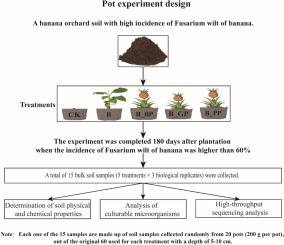Applied Soil Ecology ( IF 4.8 ) Pub Date : 2021-09-13 , DOI: 10.1016/j.apsoil.2021.104211 Jinming Yang 1 , Xiangyu Ren 1 , Manyi Liu 1 , Pingshan Fan 1 , Yunze Ruan 1 , Yan Zhao 1 , Beibei Wang 1 , RongLi 2

|
Fusarium wilt of bananas is a serious soil-borne fungal disease that currently threatens banana production worldwide. There is currently no direct and effective agricultural method for controlling the disease effectively. In this study, a pot experiment was conducted to evaluate the effects of different pineapple cultivars that were planted in a banana orchard soil with high incidences of this disease. The goal of studying this banana-pineapple plantation system was to improve the soil microbial community structure to enhance the control of a number of Fusarium in the banana soil. The soil culturable microorganisms showed that the order of the number of Fusarium from high to low was banana continuous cropping (B) > fallow (CK) > “Golden pineapple” planting (B_GP) > “Bali pineapple” planting (B_BP) > “Tai nong 17 pineapple” planting (B_PP). The MiSeq sequencing results showed that the relative abundance of Fusarium was consistent with the culturable microbial results. Banana-pineapple rotations significantly reduced the abundance of total fungi and F. oxysporum as well as the fungal diversity. The number of Fusarium were significantly reduced, and the banana-pineapple plantings changed the bacterial and fungal communities of soil microbes by increasing the relative abundance of beneficial bacterial and fungal genera such as Desulfurispora, Brockia, Gp1, and Purpureocillium, Talaromyces, respectively. In addition, planting different pineapple cultivars could reduce the soil pH, available nitrogen (AN), available phosphorus (AP) and available potassium (AK), while the organic matter (OM) was increased. Besides, different pineapple cultivars with different soil microbial community structures, and soil fertility indices significantly reduced the relative abundance of Fusarium in the banana orchard soil, and the degree of reduction was from high to low as follows: “B_PP” > “B_GP” > “B_BP”. Our result supports the good application prospects of this rotation for reducing the incidence of soil-borne Fusarium of bananas.
中文翻译:

通过种植不同的菠萝品种抑制香蕉的土传镰刀菌病原体,并比较由此产生的细菌和真菌群落
香蕉枯萎病是一种严重的土传真菌病害,目前威胁着全世界的香蕉生产。目前还没有直接有效的农业方法来有效控制该病害。在这项研究中,进行了盆栽试验,以评估在香蕉园土壤中种植该病害高发的不同菠萝品种的效果。研究这种香蕉-菠萝种植系统的目的是改善土壤微生物群落结构,以加强对香蕉土壤中一些镰刀菌的控制。土壤可培养微生物表明,镰刀菌数量顺序从高到低依次为香蕉连作(B)>休耕(CK)>“金菠萝”种植(B_GP)>“巴厘岛菠萝”种植(B_BP)>“大农17菠萝”种植(B_PP)。MiSeq测序结果显示镰刀菌相对丰度与可培养微生物结果一致。香蕉-菠萝轮作显着降低了总真菌和F的丰度。oxysporum以及真菌的多样性。的数量镰刀菌均显著减少,香蕉种植菠萝通过增加有益细菌和真菌属如的相对丰度改变土壤微生物的细菌和真菌的社区Desulfurispora,Brockia、Gp1和Purpureocillium、Talaromyces。此外,种植不同菠萝品种可降低土壤pH值、速效氮(AN)、速效磷(AP)和速效钾(AK),同时增加有机质(OM)。此外,不同土壤微生物群落结构和土壤肥力指数的不同菠萝栽培品种显着降低香蕉园土壤中镰刀菌的相对丰度,降低程度由高到低依次为:“B_PP”>“B_GP”> “B_BP”。我们的结果支持这种轮作在降低香蕉土传镰刀菌发病率方面的良好应用前景。



























 京公网安备 11010802027423号
京公网安备 11010802027423号